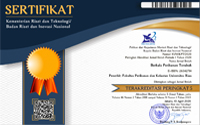Kajian Tingkat Stres Ikan Tapah (Wallago leeri) yang Dipelihara dengan Pemberian Pakan dan Suhu yang Berbeda
Abstract
This research was conducted on January to February 2015. It’s was aimed to determine the stress level of fish seed tapah (Wallago leeri) were domesticated at different temperatures and different feed doses through the observation of glucose, total blood plasma protein, absolute weight growth and survival, determining the optimal temperature and feed for the growth and survival of fish tapah at the stage of domestication. Tapah weight of fish seed used is 40-50g. The method used was completely randomized design with two factors, each factor consists of three levels. That factor is temperature and dosage of feed. Treatment with the temperature factor level as follows: 27ºC, 29ºC, and 31ºC, with the feed dose level factors as follows: 3%, 5%, and 7%. Based on the research results showed that the interaction of temperature and feed different doses give a real impact, especially on the interaction of temperature 29ºC with 5% fish feed dose test does not experience stress that is characterized by low glucose value 14.44 mg / dL, the average value total blood plasma protein of 5.35g/dL, provide the best growth in the absolute weight of 39g, and the percentage of survival of 100%. As for the temperature of 31ºC with different feed concentrations of fish are still in a state of stress that is characterized by high blood glucose levels, namely 33,57-39,67mg / dL, total blood plasma protein 2,57-2,92g / dL, absolute weight 0,87-3,450g and survival of 50-75%.
Full Text:
PDFDOI: http://dx.doi.org/10.31258/terubuk.44.3.69%20-%2083
Refbacks
- There are currently no refbacks.
Copyright (c) 2017 Heri Masjudi, Usman M Tang, Henny Syawal

This work is licensed under a Creative Commons Attribution 4.0 International License.












